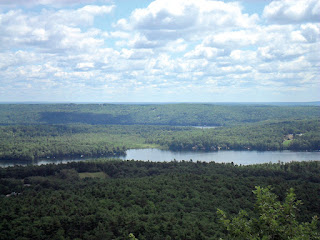By Ernest H. Knight
One of the early settlers in Raymond on Raymond Hill was Ben
Smith, who came to the area from Dover, New Hampshire as a runaway boy in 1787.
On a trip to explore a nearby mountain, Smith found it
infested with timber and common rattlesnakes and gave that spot its present
familiar name.
As a sideline to farming, Smith’s business involved catching
rattlesnakes, extracting their oil and venom, and then selling it locally and
the Portland area for its therapeutic value as a liniment for rheumatism and
anything else needing a sure cure.
To prove his product genuine, he carried live snakes with him
on his travels and attracted attention by putting a live snake inside his shirt
and letting it crawl around his body.
Smith was bitten at least once, and it was reported by his
friends that he ultimately took on one of the characteristics of rattlesnakes
in that his tongue constantly darted in and out of his mouth.
He had experimented to eliminate the hazards of his act by pulling out the snake’s fangs with the pincers he used in repairing his boots and apparently his research paid off as he lived to the age of 82, expiring in bed surrounded by a few of his reptilian pets.
Through overkill and forest fires, the rattlers eventually became
extinct on the mountain and the last known capture of a rattlesnake in Raymond
was reported at Webbs Mills about 1870.
Rattlesnake Mountain with its rocky terrain and once massive
oak forests were a source of knee, stem, keel and other pieces required for
building Maine sailing vessels. Rather than haul heavy and awkward timbers,
forks and roots to the waterfront shipyards, patterns for needed shapes were
brought to the mountain for the hewers to use in removing the excess material.
With a limited supply of suitable trees which nature could
only make by 100 or more years of growth, it is fitting that the building of
wooden ships was abdicated when the use of iron became popular for
shipbuilding.
Another product of never-ending supply but of diminished
demand is split granite building foundation for stones and walls. It was once
an active business as it was split from boulders and ledges by hand with a
hammer, rock drill and wedges.
The Berry Brothers, John, Charles, and George, who lived on
Plains Road, were practitioners of this craft and who from their outcropping on
Rattlesnake Mountain split all the stone wall surrounding Riverside Cemetery
near their home. Split stone has since given way understandably to concrete,
brick, and cement blocks though the glamour has been lost. <
This article was written by the late
Ernest H. Knight, one of the founders of the Raymond-Casco Historical Society
and contained in his book “Historical Gems of Raymond and Casco.” It was
submitted by the Raymond-Casco Historical Society and articles about Raymond
history from the historical society will appear regularly in The Windham Eagle
newspaper. To find out more about the Raymond-Casco Historical Society, call
Frank McDermott at 207-655-4646.



No comments:
Post a Comment